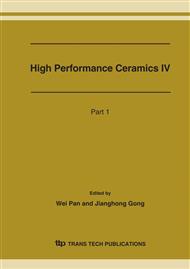p.2275
p.2278
p.2282
p.2286
p.2290
p.2293
p.2296
p.2300
p.2304
Influence of Binder Additives on the Sintering of Nano-3Y-TZP
Abstract:
Nanosized yttria stabilized tetragonal zirconia powders were prepared by chemical co-precipitation. By adding certain amount of wax emulsion, we obtained green compacts with the relative density ranged from 47% to 60%. Then the green compacts were sintered in air at the temperature from 1350°C to 1550°C. It turned out that the 3Y-TZP compacts were nearly fully densified after sintering at 1350°C and the grain sizes were between 200 to 300 nm. This result suggested that the addition of wax emulsion could improve the wettability between powders, elevated the density of the green compacts so that the coordination number and the contact points between particles were increased. With more transfer passages, the sintering behavior is remarkably improved.
Info:
Periodical:
Pages:
2290-2292
Citation:
Online since:
April 2007
Authors:
Keywords:
Price:
Сopyright:
© 2007 Trans Tech Publications Ltd. All Rights Reserved
Share:
Citation:


